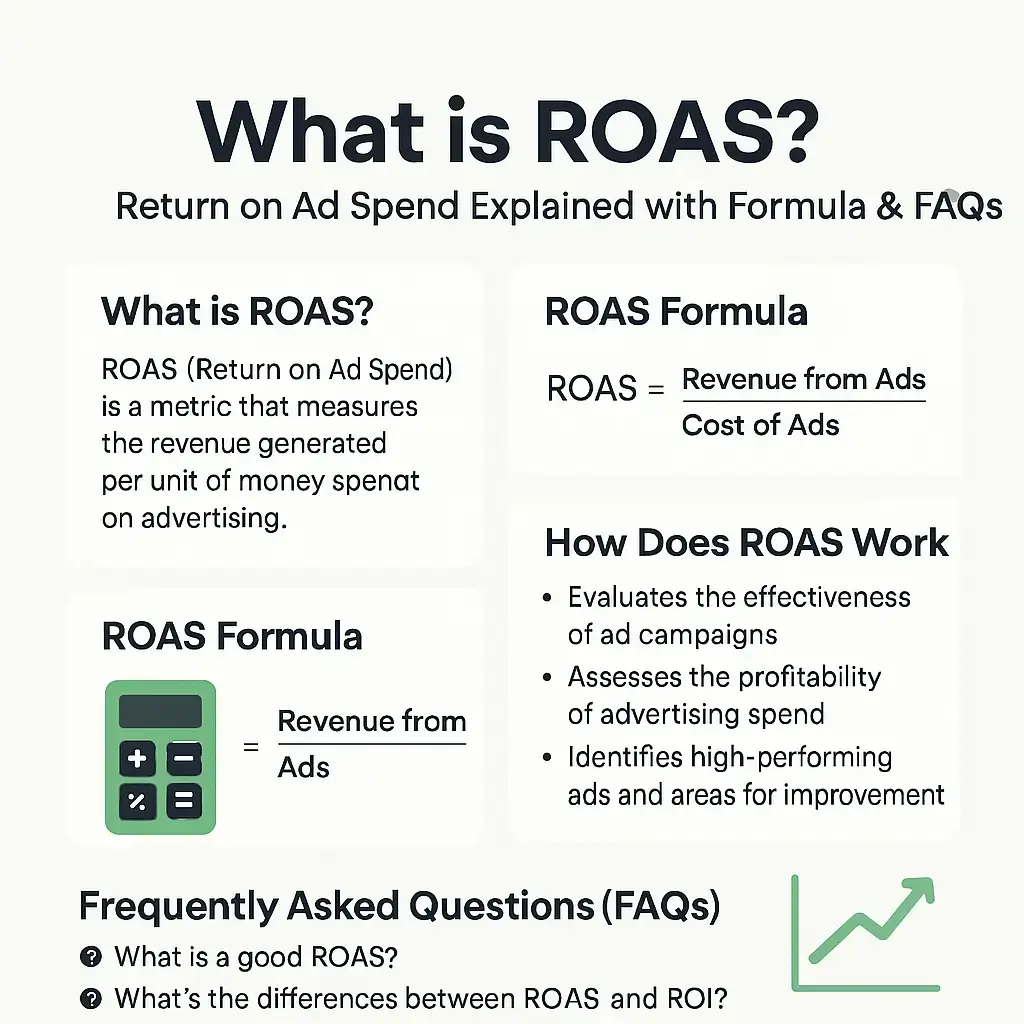📊 What is ROAS? Return on Ad Spend Explained with Formula & FAQs
In the ever-evolving world of digital marketing, measuring the success of ad campaigns is crucial. One of the most essential metrics every marketer or business owner should understand is ROAS, or Return on Ad Spend. But what exactly is ROAS? Why is it important? And how do you calculate it?
In this blog post, we’ll explore the answers to these questions and more, helping you make smarter decisions with your marketing budget.
✅ What is ROAS?
ROAS (Return on Ad Spend) is a key performance metric that measures the revenue earned for every rupee or dollar spent on advertising. It helps you understand how effective your advertising campaigns are in generating revenue.
Think of ROAS as the digital marketing equivalent of ROI (Return on Investment) — but specifically for ad spend.
📐 ROAS Formula
The formula to calculate ROAS is straightforward:
ROAS = Revenue from Ads / Cost of Ads
🔍 Example:
If you spent ₹10,000 on a Google Ads campaign and earned ₹50,000 in revenue from it:
ROAS = ₹50,000 / ₹10,000 = 5
This means for every ₹1 spent, you earned ₹5 back — a ROAS of 5:1.
⚙️ How Does ROAS Work?
ROAS works as a performance indicator to help advertisers understand:
Which ad platforms (Google Ads, Facebook Ads, Instagram, etc.) are performing best
Which campaigns or keywords are driving the highest return
How efficiently your ad budget is being spent
📊 High ROAS vs. Low ROAS
High ROAS (e.g., 5:1 or 10:1) → Your ads are performing well and generating profit.
Low ROAS (e.g., 1:1 or 0.5:1) → You’re spending more than you’re earning, and it’s time to optimize.
🧠 Why is ROAS Important?
Budget Allocation: Identify high-performing campaigns and invest more where it counts.
Performance Evaluation: Evaluate ad strategies with clear financial data.
Scalability: Helps forecast profitability as you scale up ad spend.
Optimization: Pinpoint where to reduce costs or tweak creatives.
💡 Tips to Improve ROAS
Use A/B Testing: Test different ad creatives, headlines, and CTAs.
Target the Right Audience: Use detailed targeting options for higher conversion.
Optimize Landing Pages: Ensure a seamless user experience to boost conversions.
Use Conversion Tracking: Set up proper conversion tracking to get accurate ROAS data.
Leverage Retargeting Ads: Convert warm leads who already visited your site.
🙋♂️ Frequently Asked Questions (FAQs)
A “good” ROAS varies by industry and business model. However, many businesses aim for at least 4:1, meaning ₹4 earned for every ₹1 spent.
ROAS focuses only on advertising revenue vs. ad spend.
ROI considers all business expenses vs. total revenue/profit.
Google Ads provides Conversion Tracking and reports ROAS (especially in campaigns using Target ROAS bidding strategies).
Technically, no — ROAS will show as a value less than 1 if you’re losing money. For example, 0.5 means you’re earning ₹0.50 per ₹1 spent.
Yes. Clicks and impressions are vanity metrics. ROAS shows real business impact — how much money you’re actually making.
✍️ Conclusion
Understanding and optimizing ROAS is essential for the success of any digital advertising strategy. It tells you whether your ad spend is paying off — and where to make data-driven adjustments.
Whether you’re running Google Ads, Meta Ads, or YouTube campaigns, keeping a close eye on your ROAS helps maximize your ROI and achieve sustainable business growth.

Shailesh Panchal
Digital Marketing Trainer & Consultant
9+ years of hands-on experience and as a Skill India Certified Digital Marketing Trainer, I empower businesses and teams with practical strategies that deliver real growth.
